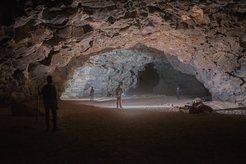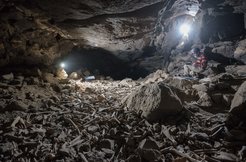Archaeological Insights from the First Lava Tube Excavation in Arabia
A recent study published in PLoS ONE reveals repeated human occupation at the Umm Jirsan lava tube from the Neolithic to the Bronze Age. The findings shed light on diets, cultural practices, and interactions with the landscape, offering a glimpse into the lives of early peoples on the Arabian Peninsula
Over the last decade, archaeological investigations in Arabia have generated new insights into the region’s ecological and human history. Finds such as ancient lake beds, human footprints, rock art and stone tools reveal that human beings have been present in Arabia for at least 500,000 years, and that the landscape was episodically much greener and wetter landscape than it is today.
Despite these advances, much about the lifestyles of early peoples on the Arabian Peninsula remains unknown. In an area where aridity often prevents organic materials from preserving, archaeological assemblages – and in particular bones – are a rare find.

But now, a recent study published in PLoS ONE reports on the first archaeological excavation of an Arabian lava tube, showing repeated phases of human occupation ranging from the Neolithic to the Bronze Age. The article presents new information on the diets of the human occupants, the animals they relied on, and the culture they created.
The researchers focused on an entrance to the Umm Jirsan lava tube, a 1.5 km underground passage formed by the flow of cooling lava. Their excavations turned up stone tools, animal bones and charcoal, all indicators of human occupation. Using optically stimulated luminescence to date the sediments and radiocarbon dating on the charcoal, the researchers show that the main phase of occupation at Umm Jirsan occurred between 10,000 and 7,000 years ago.

Analysis of the human remains at Umm Jirsan showed that people’s diets were high in protein, with an increased consumption of fruits and cereal grains coinciding with the arrival of oasis agriculture in the region.
While surveying the surrounding area, the team also found the first rock art reported in the area. Depictions of humans herding cattle, sheep and goats, and scenes of hunting with dogs, add to the picture of pastoralist groups utilizing this landscape for millennia.
“Our finds at Umm Jirsan add another important element to the story of Arabian societies over time, and how they interacted with this dramatic landscape,” the researchers say in a post on the Conversation. They hope that the current study highlights the potential for future interdisciplinary studies in the caves and lava tubes of Saudi Arabia.

